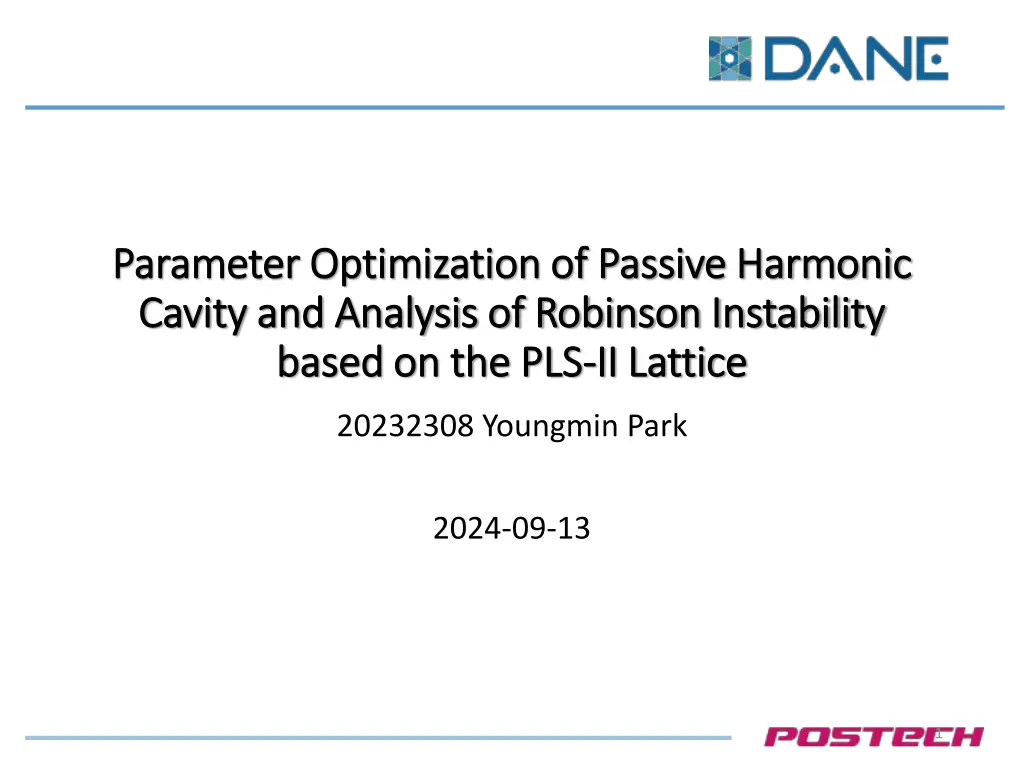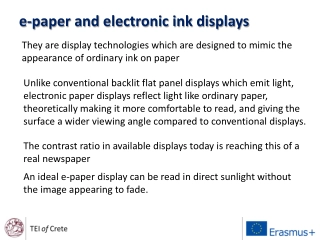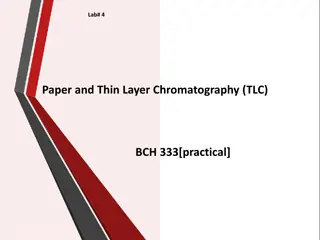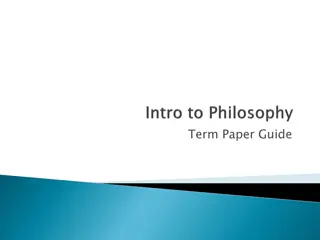
Passive Harmonic Cavity Optimization and Robinson Instability Analysis
Explore the parameter optimization of passive harmonic cavity and analyze Robinson instability based on the PLS-II lattice. The research delves into longitudinal dynamics in a storage ring, resonator impedance, Robinson instability phenomena, and the modified Robinson instability equation with radiation damping effects. Discover the interplay between beam instability and cavity impedance in this comprehensive study.
Uploaded on | 0 Views
Download Presentation

Please find below an Image/Link to download the presentation.
The content on the website is provided AS IS for your information and personal use only. It may not be sold, licensed, or shared on other websites without obtaining consent from the author. If you encounter any issues during the download, it is possible that the publisher has removed the file from their server.
You are allowed to download the files provided on this website for personal or commercial use, subject to the condition that they are used lawfully. All files are the property of their respective owners.
The content on the website is provided AS IS for your information and personal use only. It may not be sold, licensed, or shared on other websites without obtaining consent from the author.
E N D
Presentation Transcript
Parameter Optimization of Passive Harmonic Parameter Optimization of Passive Harmonic Cavity and Analysis of Robinson Instability Cavity and Analysis of Robinson Instability based on the PLS based on the PLS- -II Lattice II Lattice 20232308 Youngmin Park 2024-09-13 1
Index 2 Robinson Instability Passive Harmonic Cavity Research Process
Robinson Instability 3 Longitudinal Dynamics In general, in a storage ring, the beam loss energy by radiation, and this is replenished through the RF-cavity. ? ? 1. Above transition (? = Higher energy particles arrive later These experience an RF phase later Below transition (? = ? Higher energy particles arrive earlier These experience an RF phase earlier > 0) ? ? ? 2. < 0) Most storage rings operate above transition, the synchrotron phase must be adjusted between ? 2and ?.
Robinson Instability 4 Resonator Impedance 0 1 1 ?? 1 ?? ?? ? ? = = ??? ??? ?0 ??= 1 ??, ? = ?? ? ? ?0 1 + ?? ?? Particles passing through the RF cavity lose energy due to the resonator impedance. 0 ?? ? > 0, ?? ? = 0, 1 ??? ? = ??? ? ? ?0 ? = 2? ???0 cos ?? +? ?sin ?? ?? ? 2???? ?? ? < 0. ? ? ? =?? 2 ?2 2?, ? = ??
Robinson Instability 5 Robinson instability ? ?2?? ??2+ 2??? 2??=??0?? ?0 (?? ?? + ?? ??) ? ?= ? number of revolution,?? longitudinal displacement,?? synchrotron tune, ? number of charged particle,? slippage factor,? Circumference The beam is influenced by the cavity impedance. Under certain conditions this interaction can lead to beam instability known as Robinson instability. Let s assume that ??oscillated with respect to frequency . ?? ? ?? ?0 The frequency shift can be represented by the following equation. 2 ??2= ???0? ??0 ??0+ ?0 ??0+ ??0?0 2 ??0 ?= ??0? 2??0 ??0 ??0+ ???0 ??0+ ?? ??= ? ??0?0 2?? ?=
Robinson Instability 6 Robinson instability ??0? 2??0 ??0+ ?? ? 1= Im ?? = ??0+ ??Re ?0 2?? ?= ? > 0 ? < 0
Robinson Instability 7 Modified Robinson Instability The modified Robinson instability equation, which includes the effects of radiation damping and does not assume ??, is given by[He]: + ?2 new ??2= ??0? ??0 (??0+ )?0 ??0+ 2 new ??0?0 2 ?? ??0 ?= This can be derived by considering cases with and without damping, as follows: 1. Without radiation damping ? ? ? ? 2. With radiation damping ? ? ? ?? ? ? ?? ? ? new?, = new ?? Tianlong He, Mode-zero Robinson instability in the presence of passive superconducting harmonic cavities, PARB 26, (2023)
Robinson Instability 8 Modified Robinson Instability 2+ ?2 ??2= ??0? ??0 (??0+ )?0 ??0+ ??0?0 2 ?? ??0 ?= The beam loss are driven by the two mode of Robinson instability, beam (S) mode with ??and the cavity (D) mode 2? ??. Tianlong He, Mode-zero Robinson instability in the presence of passive superconducting harmonic cavities, PARB 26, (2023)
Passive harmonic cavity 9 Harmonic Cavity Passive harmonic cavities operate by interacting with the beam itself, while the active cavity is powered by an external generator. ? ? ? ? Active cavities Passive cavities ?cav= ?? ?cav= ?? ?? PHC(Passive Harmonic Cavity) vs AHC(Active Harmonic Cavity) 1. 2. 3. External generator supplies voltage, better for fine-tuning beam current changes. Needs extra space for the generator Cost is higher due to generator and control systems.
Passive harmonic cavity 10 Voltage of Passive Harmonic Cavity ?? ?? ? ? 1 + ?tan?=??1 ?tan? ?? = ??cos?? ?? ? ? = = 1 + tan2? 1 + ?? ?? ?? ? ? ? is tuning angle, tan? = ? ?? The beam-induced voltage on a cavity is generally expressed by the following equation. ? ? = 2????avgcos? ?0cos ?0? + ? ?0 Super conducting passive HC, the shunt impedance is very high(~? , NC ~M ): 1. Easier to set a specific voltage even at low currents. 2. The tuning angle ? is almost fixed at ? 3. It is impossible to create a flat potential. 2lengthening or ? 2shorthening
Passive harmonic cavity 11 Tuning angle In the cases of an Passive Superconducting Harmonic Cavity(PSHC), the relationship between the tuning angle and detuning is described as follows. Parameter Value 108 ? ?1 1.5 GHz
Passive harmonic cavity 12 Double rf-system with Passive 3rdHarmonic Cavity ? ? = ?1sin ?0? + ?1 + ?2sin 3 ?0? + ?2 ?0/? ? ? = ?1sin ?0? + ?1 2???avg? cos?cos 3 ?0? + ? ?0/? = ?1sin ?0? + ?1 2???avg? cos?sin 3 ?0? + ? +? ?0/? 2 ?2= ? +? ?2= 2???avg?cos?, 2 ?1 4.50 MV ? 80.03 ?0s= sin 1?0 155.52 ?? ?2 152.21 ?1s= sin 1 ?2 1sin??0 ?sin??0 170.03 ?2s= tan 1 ?2 12 ?4sin2??0 ?2 ? =1 0.2994 ?2 1sin2??0 1 ? ?2 = ??1 1.35 MV
Passive harmonic cavity 13 Hamiltonian and Vlasov equation ?? ??= ??, ?? ??=?? ? =? ?1sin ?0? + ?1 + ?2sin 3 ?0? + ?2 ?0/? ?0?0 ?0 ? ?,? = ? ??1 ?0?0 2?2+ sin ?0? + ?1 ?sin 3 ?0? + ?2 ?0/? ?? 0 The distribution function ? ?,? is expressed as follows by the Vlasov equation. ?2 2?? ??1 ?sin ?0?+?1 ? sin 3 ?0?+?2 ?0/? ?? 2+ 2 0 2??0??? ? ?,? function of ?,? ?0? ??1 ?sin ?0?+?1 ? sin 3 ?0?+?2 ?0/? ?? 2 0 2??0??? ? ? ?0? ??1 ?2exp ?sin ?0? + ?1 ?sin 3 ?0? + ?2 ?0/? ?? 2 0 2??0??? ??1 2??0??? ??2= ?2= exp ?sin ?0? + ?1 ?sin 3 ?0? + ?2 ?0/? ?? 2 0
Research Process 14 Near flat potential condition ? ? = ?1sin ?0? + ?1 + ?2sin 3 ?0? + ?2 ?0? ? 0 = ?1, ? 0 = ?2 ? 0 = 0, Introducing ? = 3?2cos ?2 ?1cos ?1, the ratio of the harmonic force to the main cavity one. sin ?1 =?0 cos ?1 3cot ?2 ?2= ??1cos ?1 ? ??1 3cos ?2 Now ?1,?2can be expressed as below. 2sin ?1 ?3cos ?1 1 1 ?2= ?1 ?0 ?1= ??1 ?0cos ?1 cot ?2 ? PSHC case ? ? 2, ?2 ? : 2 2sin ?1 = ?0 ?0 ?2= ?1 ?0 ? Alexis Gamelin, Beam Dynamics Using Superconducting Passive Harmonic Cavities with High Current per Bunch , FLS2023, Switzerland(2023).
Research Process 15 Near flat potential condition 6???avg? cos?cos ? +? ? = 3?2cos ?2 ?1cos ?1 2 = ?1cos ?1 Remain task: 1. Compare Multi-particle tracking simulation and calculated bunch length ??. 2. Complete numerical simulation of the D-mode instability 3. Need more quantitative analysis of the D-mode instability.






















